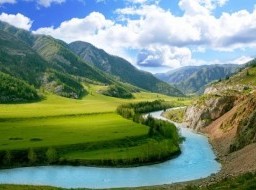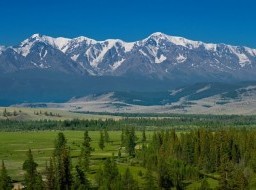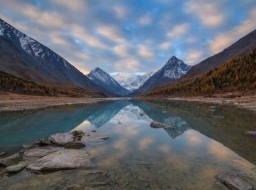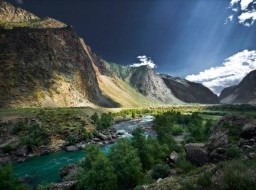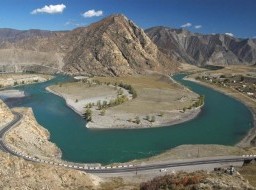Kurai Steppe
Kurai steppe intermountain basin is one of the most spectacular field of flow giant ripple in the world related with the floods from glacier lakes in ancient times. Giant ripples are well observed from the top near the Kurai Village where one can get by a car. Kurai steppe is a huge inter mountain basin with specific vegetation, mostly characterized for the desert steppes of Mongolia. Dry steppe is dotted with small and large pebbles. Steppe is bottom of a deep hollow, closed high mountains, situated at an altitude of 1500-1600 meters above sea, with up to 20 km in diameter, surrounded by ridge of North Chu, Kurai ridge from North. Kurai steppe has pronounced features of desert, it significantly differs it from the other valleys of the Altai. Annual rainfall does not exceed 200 mm. The climate is very harsh. Summer is short, hot summer days can be immediately changed by a snow blizzard. The frost-free period is less than 55-60 days. Winter is very cold, with little snow, accompanied by icy winds constantly. Steppe is characterized by sharp contrasts of temperatures of air and soil surface, during winter and summer and even during day and night. Reason is not high attitude of steppe, but keen cooling calm. In winter one can often observe with the rise attitude the air temperature rises, as due to intensive cooling of the surface, absence of wind, assisting air mixing at the bottom. As a result the coldest layers appeared under warmer layers. This phenomenon is even more pronounced for Chuya steppe. Kurai steppe vegetation is very poor. The northern slopes of the surrounding mountains are covered with forests with a predominance of conifers: larch, cedar, spruce and fir. Riverside area along the banks of the Chuya River is favorable for poplar, weeping willow with beautiful thin, bluish bloom drooping branches. Fauna is originally represented by rodents mostly: voles, pikas, marmots. It is also inhabited by steppe polecats, hares, foxes and wolves. Cranes and storks settle on riverside banks. Kurai steppe is full of archaeological sites. As a result of excavations of medieval mounds marked out special ancient Turkic culture, named "Kurai". Kurai steppe preserved numerous burial mounds, stone women, petroglyphs and remnants of ancient irrigation systems on the left bank of Chuya River. Channels are stretched for tens kilometers, breaking everything in its path. Ancient builders even breached a holes in a rock when it prevented the channel, and passes water through it. The same irrigating system also concerns Oroktoysky Suvah and channel irrigation system of Greater Ilgumen (around Khabarovla and Kupchegen Villages) Shashikmansky Suvah in the Ursul River Valley. One of the most amazing monuments in Kurai steppe are stone images, dated VII-IX centuries and belonged to the Turkic period. These monuments of history and archaeology preserved runic inscriptions and drawings. Stone image "Kaeser", stood out by its spacious shapes and sizes is on the left bank of the Chuya River, in Tete tract. "Kaeser" expresses a long-bearded man with long mustaches, curved upward semicircles. His narrow beard falls on his chest. Small mouth is hardly ever seen above the beard. The long nose, large, close-set eyes under thick eyebrows and a long beard. Not far from the mouth of Tytygema are three large stones, which are considered graves of Chinese princess, her maid, and their horses according to Kalmyk legends. The princess was married to Kalmyk zaisan, but family problems forced her to flee to China. Blizzard has stopped her in Kurai, the girl frozen with guide. Kalmyk Zaisan found bodies and buried solemnly, putting huge stones on the graves, so no one could steal the treasures buried there. But the Chinese, having learned about it, moved stones, dug the corpses and treasure, and moved it to China. Outside Kurai Village several large mounds were excavated. One of the mounds preserved remains of noble Turk had been buried in a pack with three horses and presumably a slave. Among the things laid in the grave, a silver pitcher and belt tip with runic inscriptions were found. |

